By Mike Darwin
Introduction
In order to understand the significance of the results of the Cryonics Intelligence Test and the discussion of priorities in cryonics research that is to follow (and in particular the relationship of such research to the Alcor Life Extension Foundation and the cryonics community at large), it will first be necessary to provide a substantial amount of background and context.
The first part of this context is to understand the statistics of Chronosphere. Even a decade and a half ago, the data I am about to present and discuss would have been virtually impossible to obtain. Small-scale paper, and even Internet publications, were mostly black boxes in terms of feedback. Knowing how many people viewed a given article, looked at your publication (no matter how cursorily) or took the time to download specific materials was essentially impossible. Letters to the Editor and the total number of paid and gratis subscribers (e.g., basic circulation), as well as advertisers, if any, were all the data available – plus, perhaps some demographic data on subscribers, such as what part of the country and what part of the world they resided in.
Today, with powerful statistical engines, it is possible to obtain in real time a large body of data that was heretofore not only inaccessible, it was unimaginable that it would ever be available, let alone be available at virtually no cost and with almost no effort. Having said this, it still not possible to capture the core demographic data that would provide the most useful information about the scope and depth of Chronosphere’s impact; namely the detailed demographic characteristics of the individuals accessing the site, the individual articles, the identities of those individuals, which articles they actually read, and finally, what impact those articles have on their world view, or subsequent actions. To a very limited extent it is possible to track the effect that articles and ideas in Chronosphere have on others by using Google search tools to monitor the mention of discrete articles or ideas that have appeared uniquely on Chronosphere in the blogosphere and on the Internet in general. However, this is still far from satisfactory, and such data is necessarily anecdotal, rather than comprehensive.
A Preliminary Look at the Numbers
The graph below shows the total number of hits, by month, that Chronosphere has received since its inception through, 23 May, 2012, at 1307. Since the start of Chronosphere, there have been 101,929 unique visitors to the site. During 2012 the average number of unique viewers, excluding individuals who subscribe via Google Reader Subscriber Service (RSS), is approximately 300 per day. The number of RSS subscribers has increased from ~ 80 as of October 2011 to 101 as of 23 May, 2012. The average number of new posts to Chronosphere has been 2.1 per week since its inception in February of 2011.  The table below shows the statistics for the top 10 articles being accessed as of 22 and 23 May, 2012. There is substantial variability on a day to day basis as to which articles achieve “top ten” status.
The table below shows the statistics for the top 10 articles being accessed as of 22 and 23 May, 2012. There is substantial variability on a day to day basis as to which articles achieve “top ten” status. 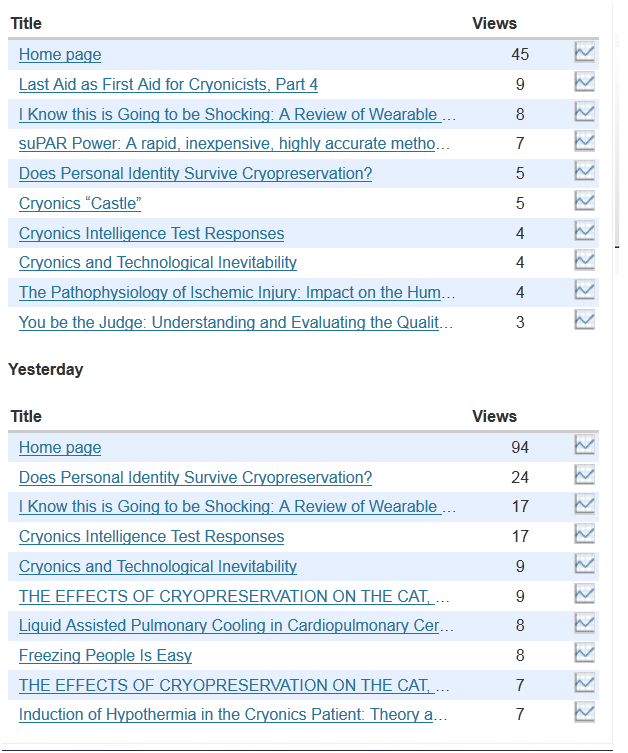 The following table shows the ranking of all articles that have appeared, from the first one, which was posted on 06 February 2011, through 23 May, 2012. These data show the number of unique hits these articles received, independent of RSS subscribers and of individuals who may have read the article, copied or downloaded it from the “Home Page.”
The following table shows the ranking of all articles that have appeared, from the first one, which was posted on 06 February 2011, through 23 May, 2012. These data show the number of unique hits these articles received, independent of RSS subscribers and of individuals who may have read the article, copied or downloaded it from the “Home Page.”
To understand what this means in practical terms, the article Robert C. W. Ettinger, First Life Cycle: 1918 to 2011, shows 2,762 discrete hits.
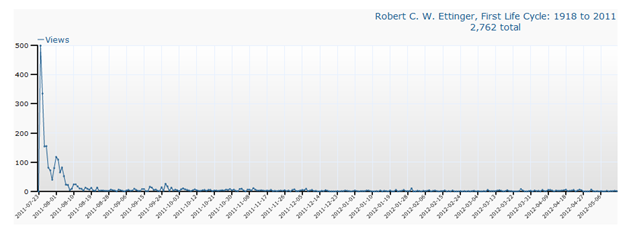 However, any examination of the aggregate number of hits for the two week period following Ettinger’s cryopreservation (boxed in red in the top graph, above), when his obituary, and a related article on media obituaries were the articles featured on the Homepage, show that the number of hits to Chronosphere increased from ~ 1,000 per day to ~ 3,000 per day. Thus, a more realistic number for views that article received is probably in the range of ~ 4,000, total. Therefore, the total “viewership” for any given article will be some total of the number of discrete hits the article receives, plus some fraction of the number of Homepage hits it received when it was the featured (Homepage) article on Chronosphere.
However, any examination of the aggregate number of hits for the two week period following Ettinger’s cryopreservation (boxed in red in the top graph, above), when his obituary, and a related article on media obituaries were the articles featured on the Homepage, show that the number of hits to Chronosphere increased from ~ 1,000 per day to ~ 3,000 per day. Thus, a more realistic number for views that article received is probably in the range of ~ 4,000, total. Therefore, the total “viewership” for any given article will be some total of the number of discrete hits the article receives, plus some fraction of the number of Homepage hits it received when it was the featured (Homepage) article on Chronosphere.
Making Sense of it All
Missing from all these data is the critically important “time on page” number. This metric helps to distinguish between “accidental,” or very casual viewers, and those who have a serious interest in the content of the article. Unfortunately, all efforts to date to add this capability (a function of Google Analytics) have proved unsuccessful. Nevertheless, the absolute number of hits a given article receives after it ceases to be the Homepage feature is very likely representative of its popularity and readership.
My personal (completely arbitrary) rule of thumb has been to assume that ~ 10% of the hits to lengthily and highly technical posts represent serious readers and that ~25% of hits for shorter, topical posts are actually read and seriously considered. What the “real” number of serious readers is for any given article is, of course, unknown. I have set my numbers so low primarily because of the nearly complete lack of commentary or embedded URL actuations most of the articles generate.
As a case in point, the extensive four-part series of articles Last Aid as First Aid for Cryonicists generated a total of only 5 comments, most of which were not of a practical nature consonant with the subject matter of the articles, which dealt specifically with how to prepare for a cryonics emergency. Some of the suggestions in the articles should have proved controversial (based on past experience in discussing them in the cryonics community) and yet, there were no dissenting comments, nor any alternative or additional suggestions offered, either on Chronosphere, or in the publications, blogs, or list-serves of the various cryonics organizations (or those serving the cryonics community as a whole, such as New Cryonet). This is in striking contrast to the author’s past experience with printed periodicals serving the cryonics community and having a comparable, or smaller number of readers (e.g., 200-300).
Some of the likely reasons for these differences between print and epublications are:
a) Subscribers paid for paper publications and thus were more heavily invested in recovering the value expended.
b) Because of the time, effort and money required to gain access to paper publications, the readership was highly filtered compared to epublications.
c) Prior to the Internet era, the total volume of information being disseminated about cryonics was very small and the available technology (e.g., the printing press) further compressed and limited dissemination of that information to a very few venues.
d) Cryonics itself was far smaller and the overlap between “activists” and “customers” was more nearly complete.
e) Cryonics publications prior to the Internet were necessarily more diverse in content than is Chronosphere due to the need to cater to a broader audience.
f) The content in Chronosphere leans heavily towards the technical and historical and is lengthily; all of which are likely to discourage the casual reader. In other words it is, by definition, a niche publication.
g) Chronosphere and its author are frequently critical of how cryonics is currently practiced as well as of the major (extant) cryonics organizations, and sometimes specific individuals who are, or who have been active in cryonics.
h) Chronosphere does not (yet) offer a blog roll nor high profile links to other organizations, sites, or publications (paper or electronic). This, coupled with the hostility generated by g) above, has resulted in a near complete lack of on-line and paper publication referrals to Chronosphere.
With these considerations in mind, let’s again take a look at how Chronosphere has performed from its inception, thru 24 May, 2012, but this time in greater detail with attention to daily and weekly numbers:
 But what do these metrics really mean? Is Chronosphere doing what it is supposed top do: raise awareness and change fundamental thinking about the way cryonics and interventive gerontological research is being pursued, as well as attracting other, like minded contributors to the site? The number of RSS feeds, the number of unique viewers and even the number of comments aren’t necessarily very useful metrics (certainly not in isolation) to determine if the effort being expended on Chronosphere is worth the return. Probably the best indicators are the combination of:
But what do these metrics really mean? Is Chronosphere doing what it is supposed top do: raise awareness and change fundamental thinking about the way cryonics and interventive gerontological research is being pursued, as well as attracting other, like minded contributors to the site? The number of RSS feeds, the number of unique viewers and even the number of comments aren’t necessarily very useful metrics (certainly not in isolation) to determine if the effort being expended on Chronosphere is worth the return. Probably the best indicators are the combination of:
a) Number of comments,
b) Number of RTs,
c) Number of downloads of white-papers, pingbacks, and “critical” URL’s accessed from the site.
d) Number of people who contribute articles to Chronosphere.
Of course, context is everything, or almost everything in this case, because Chronosphere is catering to what is, both relatively and absolutely, a miniscule community of people. To put these numbers in context, the graph below shows the traffic on the Wikipedia “cryonics” page.
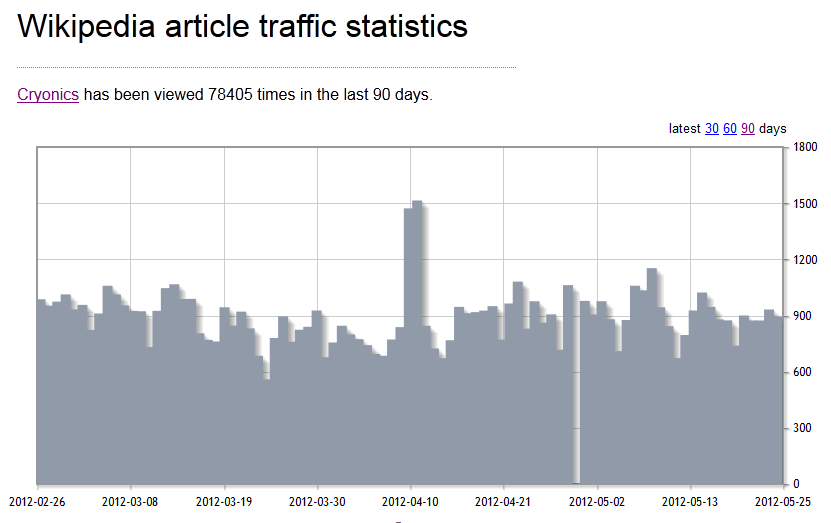 In the past 90 days there have been ~78,000 visitors or ~25,000 visitors per month, as compared with ~8,400 visitors to Chronosphere over the same time period.
In the past 90 days there have been ~78,000 visitors or ~25,000 visitors per month, as compared with ~8,400 visitors to Chronosphere over the same time period.
There are perhaps something on the order of 2,000 living cryonicists[i] in the world, the majority of them in the English speaking/reading world. Of these, optimistically, perhaps 15% are technically/scientifically/philosophically oriented “activists” with an interest in the mechanics of cryonics, as opposed to people who have chosen cryonics as a service or product “as is,” and are content to accept it without further improvement as a result of their own efforts. That would yield a number of ~ 300 people within the cryonics community who are sufficiently interested to read a publication like Chronosphere.
Even using these far more restrictive criteria, it is hard to know just how well or poorly Chronosphere is doing. Consider the cryonics self-help series of articles, Last Aid as First Aid for Cryonicists:
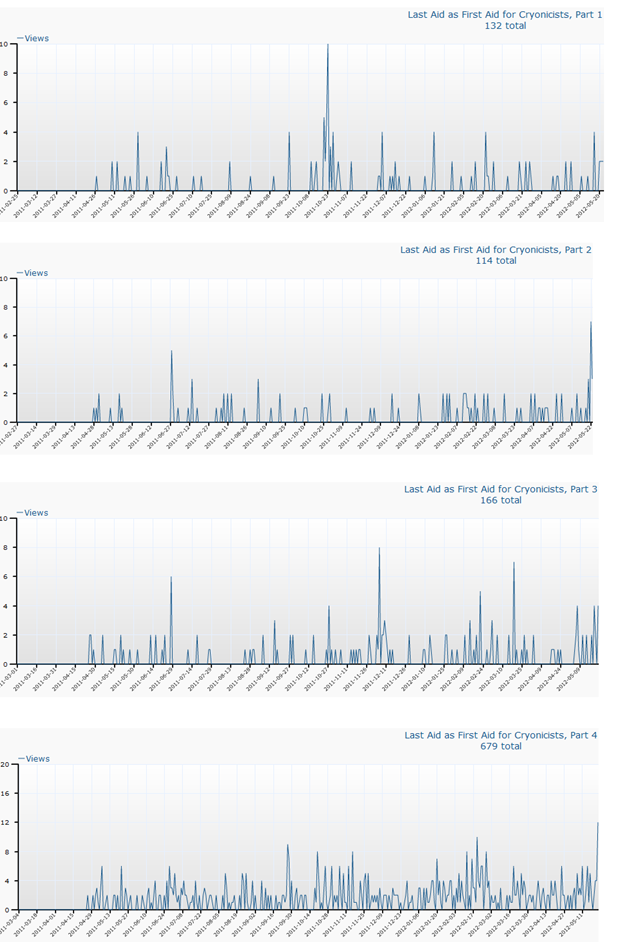 The overall performance of this series of articles is pretty dismal. However, interestingly, Part 4 in the series received the most hits, roughly three times the total that each of the preceding three parts received. This might be explained on the basis that the fourth part of the article contained the bulk of the practical suggestions for how to deal with an emergency (such as the equipment and supplies needed for cooling).
The overall performance of this series of articles is pretty dismal. However, interestingly, Part 4 in the series received the most hits, roughly three times the total that each of the preceding three parts received. This might be explained on the basis that the fourth part of the article contained the bulk of the practical suggestions for how to deal with an emergency (such as the equipment and supplies needed for cooling).
Articles that are likely to be of interest primarily to cryonicists, such as A Brief Pictorial History of Extracorporeal Technology in Cryonics show a viewership that is broadly similar to that seen for this five part series of article (below).
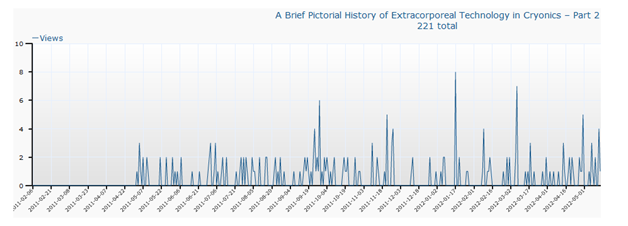
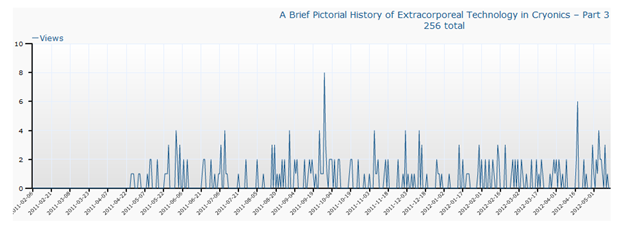
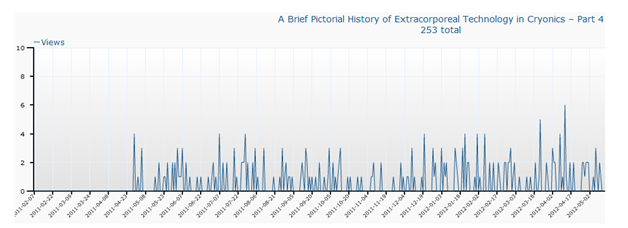
 By monitoring the search engine terms (and their frequency) being used, it is possible to get some idea of how many people are accessing these articles for reasons unrelated to cryonics, such as for information on extracorporeal medicine, specific devices mentioned in the articles and for illustrations of equipment or procedures (again, unrelated to cryonics, per se). Roughly a third of all hits fall into this category of what could be fairly called “extraneous viewers.” Again, the number of likely seriously interested viewers is probably quite small, being somewhere in the rage of 50 to 100.
By monitoring the search engine terms (and their frequency) being used, it is possible to get some idea of how many people are accessing these articles for reasons unrelated to cryonics, such as for information on extracorporeal medicine, specific devices mentioned in the articles and for illustrations of equipment or procedures (again, unrelated to cryonics, per se). Roughly a third of all hits fall into this category of what could be fairly called “extraneous viewers.” Again, the number of likely seriously interested viewers is probably quite small, being somewhere in the rage of 50 to 100.
The intermittent spiky nature of the number of hits over time is most likely the result of referrals; one person sees an article of interest, passes the URL to others and there is a brief burst of activity until that pocket of interested people is exhausted.
Similarly, technical posts which have direct relevance to medicine or biomedical research are clearly attracting viewers who are not accessing them because of any interest in cryonics. Indeed, it can reasonably be presumed they are accessing them in spite of their cryonics orientation and content, as can be seen from the data for the articles The Pathophysiology of Ischemic Injury: Impact on the Human Cryopreservation Patient, I Know this is Going to be Shocking: A Review of Wearable Continuous Monitoring Systems to Detect and Treat Sudden Cardiac Arrest in Cryonicists, Does Personal Identity Survive Cryopreservation?, Achieving Truly Universal Health Care and Induction of Hypothermia in the Cryonics Patient: Theory and Technique.
It is possible that articles that deal solely with technical issues related to cryonics, but which do not explicitly mention it, such as Liquid Assisted Pulmonary Cooling in Cardiopulmonary Cerebral Resuscitation may provide some insight into how many of the visitors accessing the explicitly cryonics-oriented technical articles are doing so for reasons completely unrelated to any interest in cryonics:
 If If this line of reasoning is indeed valid, then the number of explicitly cryonics-interested viewers is again probably somewhere in the range of 50 to 150 people.
If If this line of reasoning is indeed valid, then the number of explicitly cryonics-interested viewers is again probably somewhere in the range of 50 to 150 people.
This number is also consonant with the number of viewers that access a post which is almost exclusively of interest to cryonicists, such as the series of articles, Much Less Than Half a Chance, on using medical imaging to reduce the number of sudden and unexpected deanimations (cardiac arrests) amongst cryonicists:
and Your Picture Won’t Be Hanging Here?:
More problematic to interpret are articles which deal with technical matters of a nature, interest in which one would expect would be largely or completely confined to cryonicists, such as the (so far) three-part series, The Effects of Cryopreservation on the Cat, which has generated sustained and (relatively) substantial interest, with Parts 2 & 3, wherein the results of the study are presented, having received a total number of views of ~ 1,800:
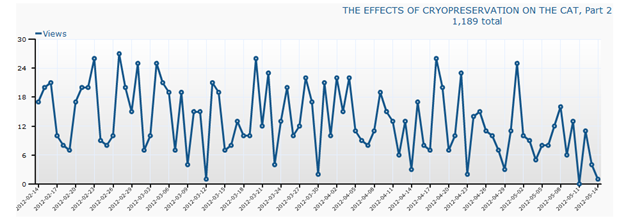
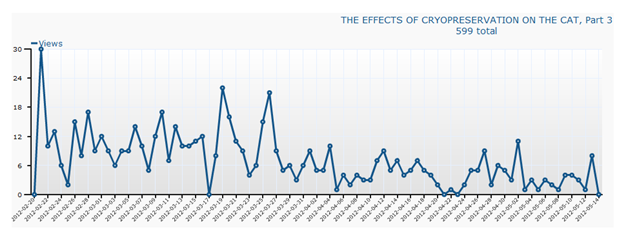 This is comparable to the degree of interest shown in most “data/conclusion-dense” part of the series of articles on brain degeneration in aging, Going, Going, Gone…:
This is comparable to the degree of interest shown in most “data/conclusion-dense” part of the series of articles on brain degeneration in aging, Going, Going, Gone…:
However, it bears pointing out again that the more specifically cryonics oriented an article is, the smaller its readership will typically be, as was the case in the Cryonics: Failure Analysis Lectures, 1 & 2:

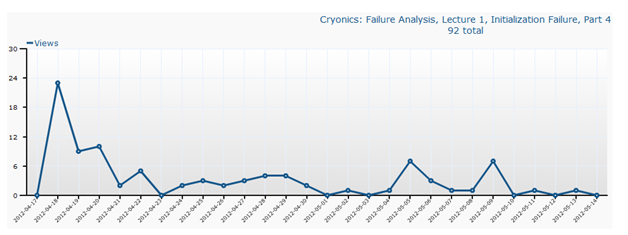
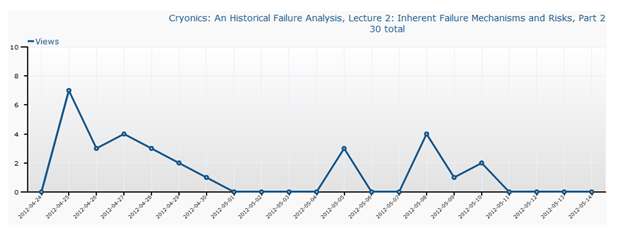 and the article Freezing People is Easy:
and the article Freezing People is Easy:
Below, I’ve presented the statistics on a range of other types of articles without comment, in large measure because it is hard to know how to interpret the data:
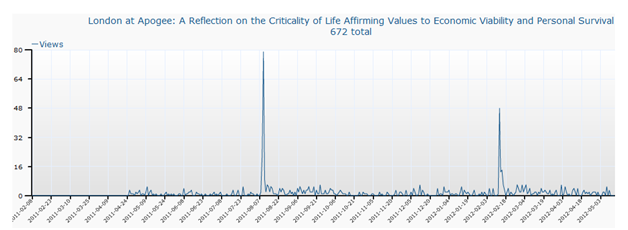

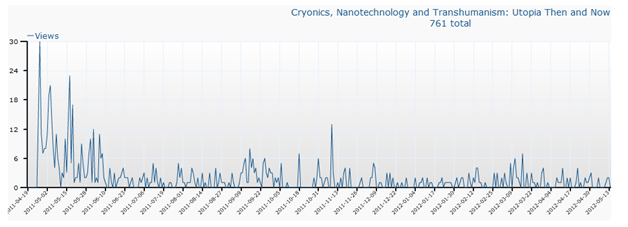
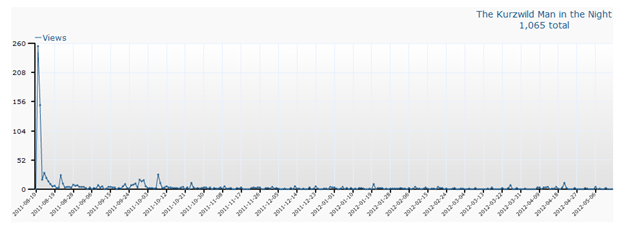
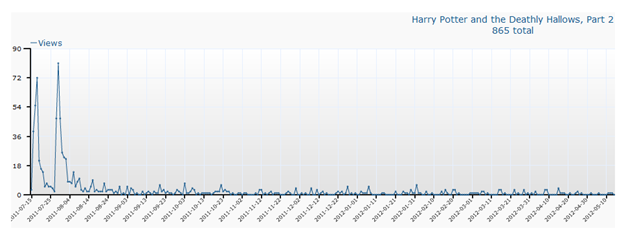
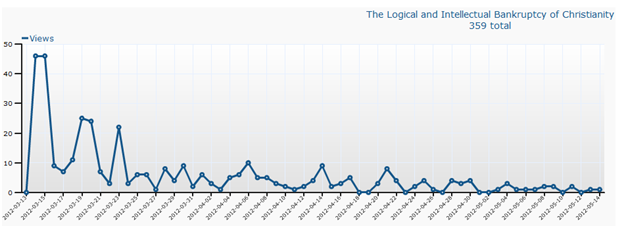 And finally, we come to Take the Cryonics Intelligence Test which was designed as a seminal experiment to probe both the readership of Chronosphere and the cryonics community at large. Leaving out of consideration the number of people who may have read this article during its tenure on the Homepage, 193 people accessed it as of 24, May, 2012:
And finally, we come to Take the Cryonics Intelligence Test which was designed as a seminal experiment to probe both the readership of Chronosphere and the cryonics community at large. Leaving out of consideration the number of people who may have read this article during its tenure on the Homepage, 193 people accessed it as of 24, May, 2012:
and only 82 people were interested enough to view the results of the test:
Even more interesting (and telling) is metric for the number of people who downloaded the Resource Materials for the test from Yousendit, a mere 22 souls:  of whom two bothered to actually take the test.
of whom two bothered to actually take the test.
These numbers seem dismal to me, all the more so when, in the next few installments here, the issues involved (dealing with the principal subject matter in the Cryonics Intelligence Test and the Cryonics Intelligence Test Responses) are explicated and put into context and their importance (hopefully) made apparent to even the least technically inclined readers of Chronosphere.
Finally, it would be most useful to see similar performance metrics from other cryonics and life extension related blogs and websites. It is virtually impossible to evaluate the performance of this effort without any benchmarks to compare it to.
Footnote
[i] Excluding the ~200 patients now cryopreserved.



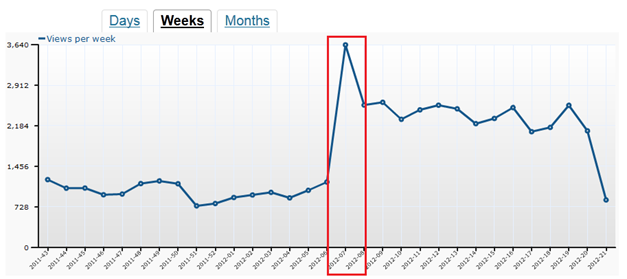
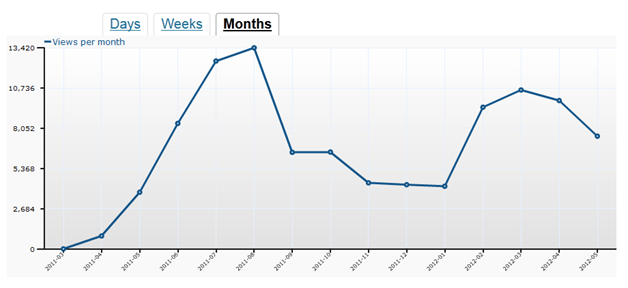
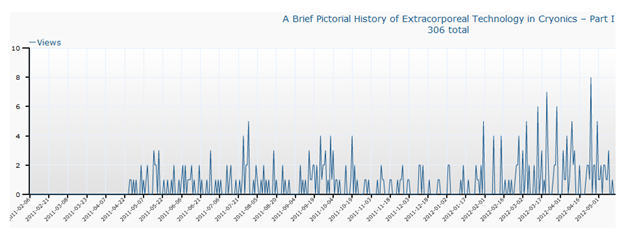
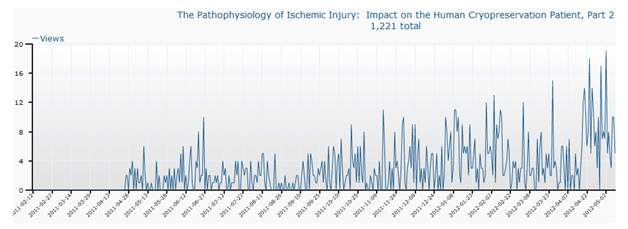

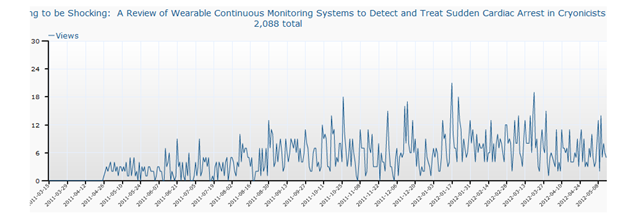



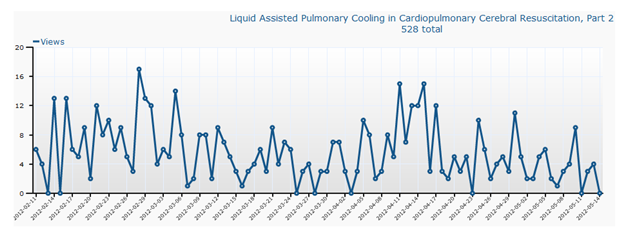
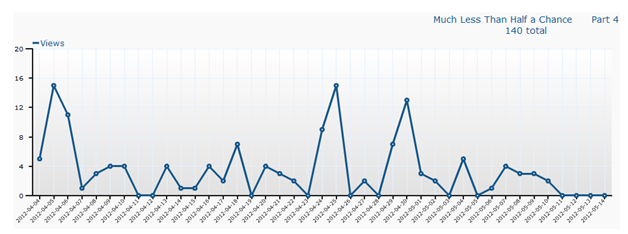

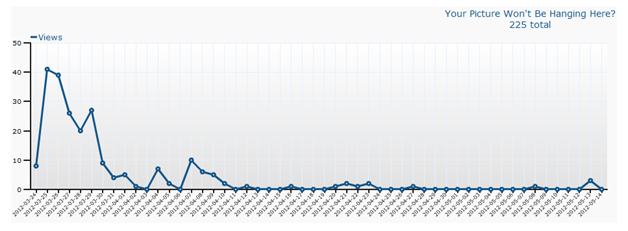
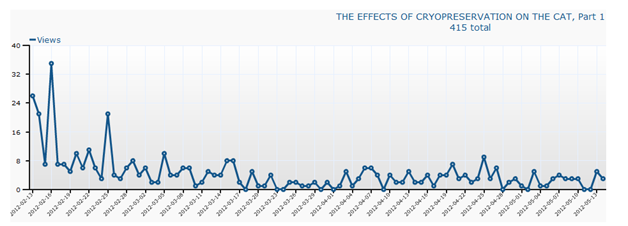

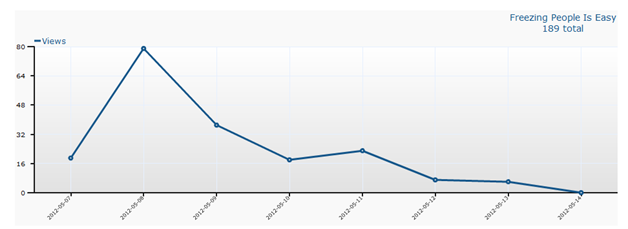
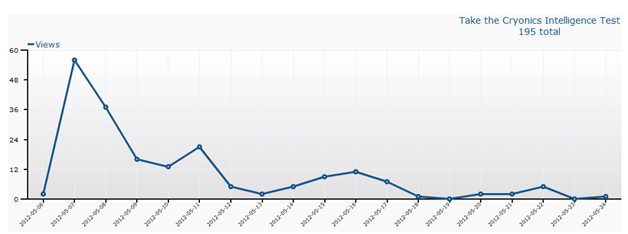
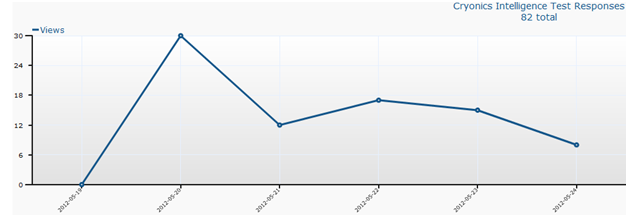
Again, I find myself surprised that this article has provoked not a single comment. There is a lot of data in this post – much of which I cannot interpret. But, perhaps more importantly, there is a complete lack of context in which to interpret the data, because there are no publicly available data (that I know of) on how other on-line cryonics information venues are performing. I’m surprised that members and contributors to Alcor, ACS, CI, the Cryonics Society and other cryonics related blogs and websites do not ask for, or even demand accountability for the performance of these venues.
I can go to http://stats.grok.se/en/latest90/Cryonics, which is the statistics page for the Wikipedia “cryonics” entry and discover that the cryonics page has been viewed 78,405 times in the last 90 days. What’s more, I can get far more detailed statistics, if I so choose. How do the websites and blogs of other cryonics and cryonics-related on-line venues compare?
The no-feedback problem is, to a considerable extent, an inherent flaw in the biomedical aspects of cryonics. However, in almost every aspect of cryonics operations it does not pertain. Over the ~50 year history of cryonics the most consistent complaint and the most called for item for action (by members and non-members alike) is to somehow improve or or remake the *marketing and communication* of cryonics to the world at large, and to the various micro-communities within it, that might have a special susceptibility to our message.
And yet, from this area of endeavor, which now operates mostly on-line, there is unarguably even less feedback about success or failure (or even just straightforward raw data) than there is from the physical cryopreservation process itself.
I find that incredible.
The only thing I find more incredible is the absence of curiosity about this issue on the part of the ~2K cryonicists now inhabiting the planet. Statistical engines of enormous power are now available essentially for the trivial cost in time of learning to master them, and the only slightly greater cost in time of putting them to use and reporting the data – whether it is interpreted in-house, or not.
Cryonicists long endlessly for the powers of the gods – and yet, when given them in telecommunications, computing, data accessibility and analysis – they do not use them and indeed, are seemingly oblivious to their very existence
How very strange. — Mike Darwin
>Cryonicists long endlessly for the powers of the gods – and yet, when given them in telecommunications, computing, data accessibility and analysis – they do not use them and indeed, are seemingly oblivious to their very existence
Well, gee, Mike. I guess I don’t have to give my talk next week end. You’ve done a lot of it for me.
Actually I wanted to explore whether cognitive science can shed some light on why the cryonics idea fails to communicate. Our current educational system tends to teach us a way of thinking dating probably from Cartesian philosophy in the 17th Century, which I call “Cartesian reason” (CR), that just happens to get a lot of things wrong about how the mind works according to the current findings of cognitive science.
For example, CR holds that people generally act in their rational self interest. But cognitive linguist George Lakoff argues instead that people act according to frames of values and identity/relationships, which often conflict with rational self-interest. (Lakoff has a political agenda and argues that the framing process makes people vote against their self interests when they vote for conservatives, when I don’t think that necessarily follows.) That would explain why men concede that cryonics could serve their self interest in staying alive, but they don’t want to sign up because it would upset their wives or make them lose status among their colleagues by doing something “weird.”
Similarly, the CR model holds that “the truth will set us free,” whereas cognitive science has found that the mind processes ideas through frames, again, and rejects the ones which don’t fit into the frames even if the facts and the inferences support them. Cryonics has some serious framing issues which come up every time a cryonicist talks about getting frozen “after death,” or wanting to “cheat death,” or otherwise alluding to the death frame. We would probably do better to frame cryonics consistently as a form of experimental medicine where we treat cryonauts as stabilized trauma patients with currently unknown prognoses which depend on the progress of medicine.
Unfortunately CI has already capitulated to regulation as a “cemetery,” which doesn’t help at all in framing cryonics in ways favorable to us. (That shows the disadvantages of CI’s threadbare financial model: it lacks the resources to protect itself legally, and it probably will lose other legal challenges in the future for the same reason.) We cryonicists talk a good game about our intellectual sophistication, but our adherence to the naive CR way of thinking when, for example, conservative think tanks have given conservative ideas traction in the culture through the sophisticated application of framing and the use of the media, shows that we have fallen behind the times. And we would also benefit from cracking open a neuroscience textbook and learning the subject before we post stuff about the brain on the internet which makes neuroscientists like P.Z. Myers laugh at us.
But then what do I know? I just run a motel.
I’m sure your talk will be excellent! And in any event, if you gave it 4,000 times; twice to every cryonicist in the world, you would still be a refreshing speaker with a refreshing topic and much work to do. I would really like for you write an article, or put the text of your talk here, on Chronosphere, even if you publish it elsewhere, first. It is an important part of the “insight” that is being generated here – not just by my articles, but by the comments. Comments which have had equally important thoughts and insights – those from you and Cath Woof come immediately to mind.
Framing has been used with mind-boggling success by gay activists to successfully sell a lifestyle that has greater associated morbidity and mortality than moderate tobacco and alcohol abuse combined. Surely cryonics can achieve some small fraction of that success with sound science, competent communications (aka marketing) and excellence in the delivery of its physical and social services. It is now clear, or soon will be, that the extant cryonics organizations are not capable of doing that. They want to do it, they understand that the need to do it, but they simply cannot. I am increasingly convinced that, one way or another, that vacuum will not long remain unfilled. — Mike Darwin
I have one cryonics-only page for which I could provide any analytics: http://dl.dropbox.com/u/5317066/2011-2012-plastination-analytics.pdf
By all means! Let see them! I have also looked at the stats for Wikipedia pages for CI, Alcor, and a number of related individuals and topics. They have been eye-opening. The Alcor Wikipedia page had ~3,5000 visitors in the last 30 days as compared with ~8,400 visitors to Chronosphere over the same time period. Now, it is likely that fractionally more of the visitors to the Alcor Wikipedia page were “serious” visitors seeking information about Alcor and cryonics than is the case with Chronosphere. However, if even half of the visitors to Chronosphere are, in fact, seeking information directly related to cryonics (the overwhelming topic on Chronosphere) then we are doing considerably better than the Alcor Wikipedia page.
That may have even more significance than it might appear at first blush, because Alcor Wikipedia page visits are likely to serve as surrogate marker (+ or – say, 50%) for the number of visits to the Alcor webpage. The number of visits to the CI Wikipedia page was 1,660 over the same 30 day period. I believe this disparity between Alcor and CI is likely in significant that both the Alcor Wikipedia and Alcor Alcor web pages offer more attractive and diverse content.
The surprising – no shocking – thing for me was to realize that cryonics and the two largest cryonics organizations attract so little (both absolutely and comparatively) little interest on the premier free go-to site for information about just about anything the world over (Wikipedia). I had imagined that if Chronosphere was getting ~8,400 visitors a month that the Wikipedia cryonics page must be getting at least several orders of magnitude more and Alcor’s own webpage vast more in the bargain. Ditto “Evidenced Based Cryonics” – “Depressed Metabolism,” and the “Cryonics Society” website. Looking for surrogates for the “popularity” of cryonics has forced me to rethink this, and to rethink the apparent “failure” of Chronosphere.
Ain’t science wonderful?
Send me your stats and I’ll integrate them, along with the others I’ve mentioned above, into the article, or an addendum to it. — Mike Darwin
Your stats would have been far more meaningful if the main page of your blog did not have copies of all the articles. The main page should have links only. I remember that it took me weeks to figure out that all comments were on sub-pages. An important rule of site organization is to not have the same data in two places. If I had known that you were this interested in metrics, I would have mentioned it earlier.
My understanding is that the statistical engine only counts posts accessed directly – not those that are up on the homepage or are scrolled to by accessing the homepage. For my purposes (so far) that’s acceptable, because, if anything, it will yield a lower number of views per page – which is probably more reflective of the actual interest.
I want to be clear that I am not resistant to making the changes you suggest, I simply have no idea how to go about it. I have a singular lack of aptitude in this area, and while I am not proud of that fact, neither am I ashamed of it. Nobody is good at everything, and while I am very good at a number of things; alas, this is not one of them. I only recently discovered how to obtain statistics for individual posts by accidentally clicking on the microscopic icon which appears next to the titles of those posts which make the “top lists” on the stats page. All of my attempts to add plug ins, and to modify features, have either failed, or caused problems. This is simply not my forte.
The only person who has provided material help with the blog is Eugen Leitl, who is in Germany, has a family, a demanding job, and is, in short a busy person. Since Chronosphere was launched, I have made a number of requests for support of various kinds – everything from help in preparing a checklist to evaluate cryonics organizations, to requests for writing input, ranging from book and movie reviews, to feature articles. One person did submit an article for publication, but other than that, there has been no response. I am grateful for the comments received, but they are surprisingly few in number, albeit quite high in quality. This lack of interest, involvement and “traction” (as Mark Plus so elegantly puts it) has made me dubious about continuing my efforts here. Which brings me to to the issue of metrics.
I am critically interested in metrics because I am, first and foremost, a scientist. Numbers aren’t everything, and they can be pretty useless absent the proper context for interpretation. Unfortunately, the data I really need are, to my knowledge, not accessible. What I would really like to know is who and how many people of a certain demographic are being materially influenced by what appears here? Clearly, if all my avid readers are 90+ year old residents of care homes, the long term impact of what I’m doing here will be nil. Raw numbers of hits, or even numbers with “time on page,” don’t amount to much if the readers are not getting the message or are (for whatever reasons) completely disempowered or disinclined to act on it.
I sometimes wonder if I am repeating the Saul Kent/CSNY mistake of the late 1960s and early 1970s with CRYONICS REPORTS, CSNY’s monthly magazine. CRYONICS REPORTS had (for the time) very high production values relative to what was actually present organizationally (essentially nothing). It was, in fact, impossible for most people to understand that the magazine was essentially the work of one man – one man working pretty much alone. That misunderstanding shouldn’t be the case with Chronosphere, because, due to computing technology, I am not only producing Chronosphere alone, I am producing it in essentially total isolation. There is no “office staff” nor any “distributed staff” to consult with. Communication with Eugen regarding the mechanics of the blog is extremely difficult, because he is not here to show me, step by step, how things work. This is, BTW, why, despite the marvels of Skype and computing, people still have such synergy when they are working together in the same place; otherwise there would be none of those costly, sprawling edifices housing Google, Facebook, and other such venues in Silicon Valley. Computers give the illusion of a broad bandwidth of communication, when in reality, it is still relatively narrow. Despite the visceral disgust it evokes in me, one function of social network apps like Twitter and Facebook is to emulate the broad bandwidth of communication that exists when people are in each others’ presence. For instance, if I were to announce that I corresponded with the late Richard Fenyman, and therefore knew him well, no one would give the slightest credibility to such an assertion. However, if I stated that I lived with him for a year, well, that’s another matter altogether. [For the record, I did neither.]
And so it goes with efforts like this one. I’m doing what I do really well here. But I can’t (and won’t attempt) to do what I can’t do here ;-).
Finally, this is all just by way of explanation. The above isn’t delivered as either a rant or a complaint. Neither would do any good, and in any event, they don’t reflect my state of mind. This is just the way it is, and other than explaining that, and reaching out for assistance as I have done in the past, I don’t know that there is anything more that can be done or said. — Mike Darwin
I’ve been reading sporadically for perhaps six months but never commented before. I really appreciate the dissemination of expert knowledge and your personal passion, though I have little free time at the moment to devote to cryonics issues. In my misspent youth, I worked on a metrics team for an online video startup. A lot of what I learned is intensely banal: sex sells, engagement follows a power law, there will be a handful of regulars, a larger number of semi-regular casual users, and most people show up once and never return. The best place I know on the web to find low-effort high-impact thinking on the subject of knowledge driven web optimization is Jakob Nielsen’s newsletters on practical usability research. A lot of these techniques gain their value in light of concrete goals for a website, operationalized in terms of things that can be directly measured. Do you want people to buy a book? Do you want them to join an organization? Sign up for a mailing list? Do you want to plant seeds and water them so that many people learn each of the 200 things that will lead them to participate in cryonics 10 years from now, even if they never engage with you directly?
I wouldn’t want your blog to lose its intellectual tone in favor of “glib accessibility”… but at the same time I think some of the graphs you show (and thus some of the reality behind the data) appear chaotic because small issues (like how pithy and intriguing the titles are) are probably having outsized impacts on what is read and what isn’t. Find out why you want to click on this!
What I value about your blog is the unique voice and content that seems deeply based in both experience and theory. I predict (but am not sure) that I would be fascinated to read a lot of little “Aesops” in the form of real stories from real life, that taught you important and practical lessons related to cryonics activism.
For myself, something that has caused me to not come back to your blog regularly was the sense that I arrived late to a party that is already winding down. It seemed that you viewed the blog as a temporary experiment, were moderately dissatisfied with the outcome of the experiment, and thus were likely to not post very much of interest going forward. This was months ago, but it suggested the best content was in the past so I went trawling through the archives in a new browser window, opened about 20 of the most interesting sounding articles in new tabs, and spent spare minutes over the next few weeks reading and then closing tabs in that window (with minor tab explosions based on outlinks and tangents) boiling the intellectual gestalt down to a few of the most informative pages.
If you want to grow an enduring community of readers and commenters you need to engage people’s dopamine-driven “temporal difference learning” processes by giving them a single action that semi-reliably delivers something of surprisingly high value… basically get them addicted to your landing page. Writing more and smaller essays and encouraging readers to expect more such content extending off into the arbitrary future might be helpful here. Again, a lot depends on what you actually want to accomplish with the site, and how much of this can be operationalized in terms of website metrics. Operationalizing can be very tricky.
“What are you doing?”
“Looking for my keys.”
“Where’d you lose them?”
Pointing… “Way over there!”
“Then why are you looking here?!”
“The light is better.”